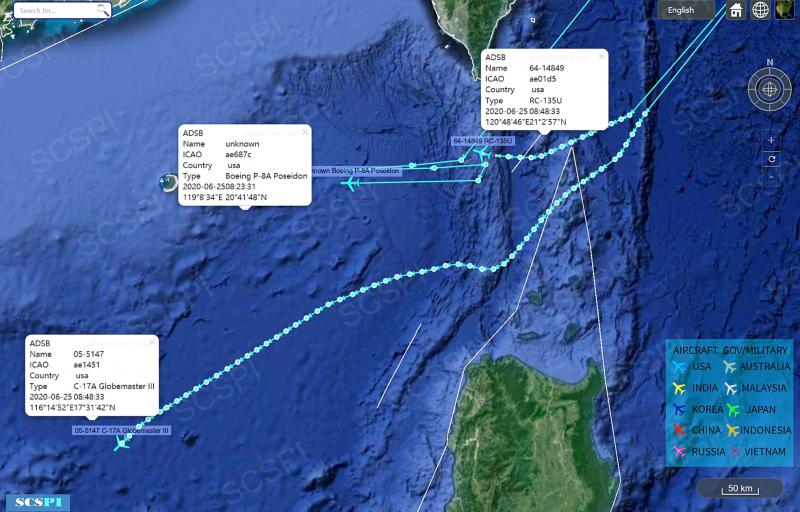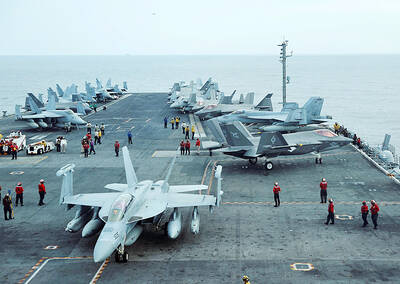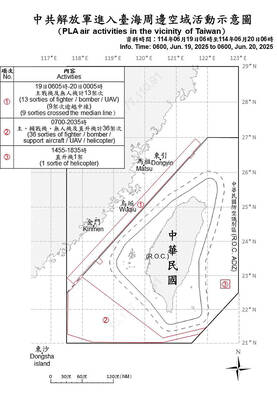Three US Air Force reconnaissance aircraft — one P-8A Poseidon, one RC-135 and one C-17A Globemaster III — were yesterday observed heading toward the South China Sea and the Bashi Channel, after five US military planes had been sighted in the area a day earlier.
According to the Beijing-based South China Sea Strategic Situation Probing Initiative (SCSPI), the P-8A Poseidon was performing anti-submarine patrols between the Pratas Islands (Dongsha Islands, 東沙群島) and the Bashi Channel.
The US Air Force had deployed two P-8A Poseidons, one P-3C Orion, one RC-135 and one KC-135 Stratotanker refueling craft over the Bashi Channel area on Wednesday, according to SCSPI data.

Photo: Screengrab from China’s South China Sea Strategic Situation Probing Initiative’s Twitter account
The high frequency of the US deployment in the region is to prevent China’s People’s Liberation Army Navy (PLAN) from sneaking ballistic missile submarines into the Philippine Sea, from where submarines carrying intercontinental ballistic missiles would be in range to potentially launch attacks on the US mainland, Tamkang University Center for Advanced Technology executive director Peter Su (蘇紫雲) said on Wednesday.
A source in the Taiwanese military, speaking on condition of anonymity, said that the US Air Force might have received intelligence about a potential deployment of PLAN submarines.
The number of passes and the variety of aircraft dispatched to the region could be an indication that the US is conducting trials to gauge the reliability of a possible joint-operation mission in the South China Sea, the source said.
Separately, the Ministry of National Defense on Monday announced that it is temporarily redeploying marines to Pratas Islands in response to the PLA’s planned exercises in August.
A Kyodo News report said that the PLA is planning to hold a beach-landing exercise in the South China Sea, with the scenario of landing on the Pratas Islands.
The ministry’s Office of the Deputy Chief of the Central Staff for Operation and Planning Joint Operations Division Major General Lin Wen-huang (林文皇) has said that the Coast Guard Administration (CGA), trained by the marines, were equal to the marines in combat capability and could defend the islands should they come under attack.
The redeployment is temporary, with the main objective of maintaining the CGA’s combat readiness and strengthening its logistics defenses, the ministry said.
Such exercises are conducted annually and are nothing out of the ordinary, it added.
Additional reporting by CNA

China might accelerate its strategic actions toward Taiwan, the South China Sea and across the first island chain, after the US officially entered a military conflict with Iran, as Beijing would perceive Washington as incapable of fighting a two-front war, a military expert said yesterday. The US’ ongoing conflict with Iran is not merely an act of retaliation or a “delaying tactic,” but a strategic military campaign aimed at dismantling Tehran’s nuclear capabilities and reshaping the regional order in the Middle East, said National Defense University distinguished adjunct lecturer Holmes Liao (廖宏祥), former McDonnell Douglas Aerospace representative in Taiwan. If

TO BE APPEALED: The environment ministry said coal reduction goals had to be reached within two months, which was against the principle of legitimate expectation The Taipei High Administrative Court on Thursday ruled in favor of the Taichung Environmental Protection Bureau in its administrative litigation against the Ministry of Environment for the rescission of a NT$18 million fine (US$609,570) imposed by the bureau on the Taichung Power Plant in 2019 for alleged excess coal power generation. The bureau in November 2019 revised what it said was a “slip of the pen” in the text of the operating permit granted to the plant — which is run by Taiwan Power Co (Taipower) — in October 2017. The permit originally read: “reduce coal use by 40 percent from Jan.

‘SPEY’ REACTION: Beijing said its Eastern Theater Command ‘organized troops to monitor and guard the entire process’ of a Taiwan Strait transit China sent 74 warplanes toward Taiwan between late Thursday and early yesterday, 61 of which crossed the median line in the Taiwan Strait. It was not clear why so many planes were scrambled, said the Ministry of National Defense, which tabulated the flights. The aircraft were sent in two separate tranches, the ministry said. The Ministry of Foreign Affairs on Thursday “confirmed and welcomed” a transit by the British Royal Navy’s HMS Spey, a River-class offshore patrol vessel, through the Taiwan Strait a day earlier. The ship’s transit “once again [reaffirmed the Strait’s] status as international waters,” the foreign ministry said. “Such transits by

Taiwan is doing everything it can to prevent a military conflict with China, including building up asymmetric defense capabilities and fortifying public resilience, Vice President Hsiao Bi-khim (蕭美琴) said in a recent interview. “Everything we are doing is to prevent a conflict from happening, whether it is 2027 or before that or beyond that,” Hsiao told American podcaster Shawn Ryan of the Shawn Ryan Show. She was referring to a timeline cited by several US military and intelligence officials, who said Chinese President Xi Jinping (習近平) had instructed the Chinese People’s Liberation Army to be ready to take military action against Taiwan